Recent Articles
Popular Makes
Body Types
2020 Audi R8 Road Test and Review
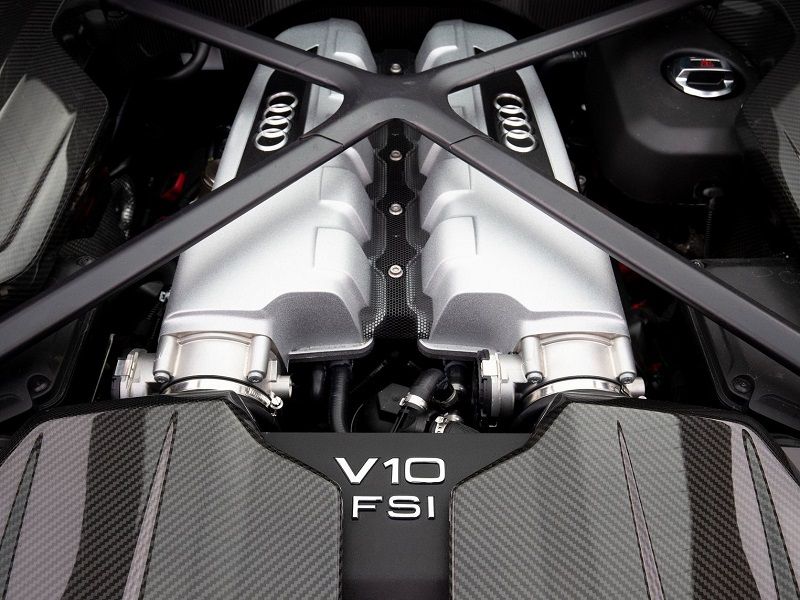
2020 Audi R8 Coupe Engine V10 ・ Photo by Audi
Audi introduced the original R8 back in 2008, and it was an immediate hit. The brand's first mid-engine supercar brought a sexy design, extreme performance, and livable everyday comfort. Plus, it was all-wheel drive, which wasn’t very common in the world of supercardom. This year, the two-seater — now deep into its second generation — has been updated significantly with improvements to its exterior styling and its performance.
The 2020 Audi R8 is more powerful, and Audi has revised its suspension and added stickier tires to improve its handling. All-wheel drive remains standard on all models, but R8 ownership remains an exclusive club, as prices start at over $170,000. Audi only sells about 1,000 examples a year. Rivals include the Ferrari F8, Lamborghini Huracan Evo, Acura NSX, BMW i8 hybrid, several McLarens, and the new 2020 Chevrolet Corvette.
Like a Lamborghini, But Built in Germany
Like Lamborghini, Porsche, Bentley, and Bugatti, Audi is owned by Volkswagen, one of Germany’s largest automakers. Welcome to the global industrial age. Because of this reality, the 2020 Audi R8 shares much of its chassis, powertrain, and other components with the 2020 Lamborghini Huracan EVO. Both mid-engine machines use the same V10 engine, seven-speed dual-clutch automatic transmission, and all-wheel drive and suspension systems.
But don’t mistake the R8 for a Huracan wearing the Audi rings and grille, as there are significant differences between the two. Unlike the Lambo, which is assembled in Sant’Agata Bolognese, Italy, the R8 is built in Heilbronn, Germany. It also has a 2.4-inch longer wheelbase, and its interior is completely unique and far more friendly for everyday use. The Audi is also quite a bit less expensive.
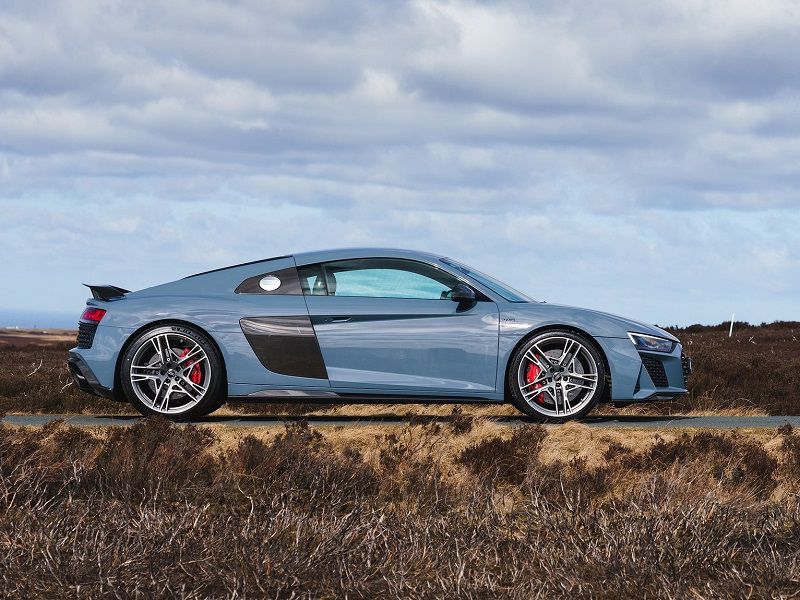
Photo by Audi
Offered as a Coupe or Convertible
Available as a two-seat coupe or convertible, the 2020 Audi R8 is powered by an all-aluminum V10 engine backed by a seven-speed dual-clutch automatic transmission. There are two models: the base V10 and the more powerful Performance. The base price is $172,850, including a $1,700 gas-guzzler tax and a $1,250 destination charge. A base V10 R8 Spyder, which has a power-operated soft top, costs $185,050. Yes, those numbers are mouthwatering, but the R8 is downright cheap compared to a Lamborghini Huracan EVO, which has a base price of $261,274.
Step up to the more powerful Performance models and the R8’s base prices jump to $198,850 for a Coupe and $211,050 for a Spyder like our test vehicle. With options, which included a Sport Seat Package with diamond stitching and a Bang and Olufsen sound system, our test car cost $219,145. Standard equipment includes a chassis made of aluminum and carbon fiber, massive carbon fiber brakes, 20-inch forged aluminum wheels, and ultra-wide high-performance Michelin tires.
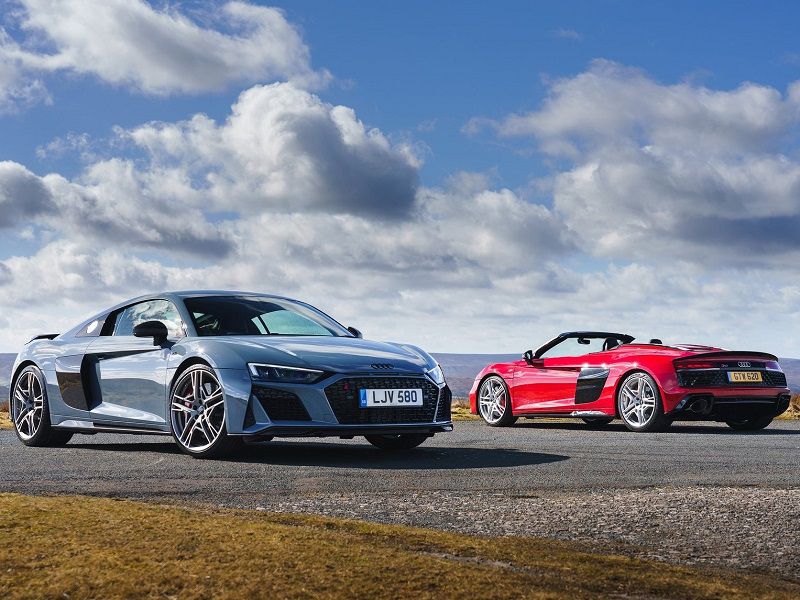
Photo by Audi
Howling V10 With up to 602 Horsepower
With most supercars in this price range featuring engines with twin-turbochargers, the Audi’s naturally-aspirated, large displacement 5.2-liter V10 is a bit retro. In the base V10 model, it produces 562 horsepower — an increase of 30 hp over the last year’s model. Audi says the R8 Coupe can now accelerate from 0 to 60 mph in 3.4 seconds and the Spyder, which weighs about 280 lbs more, can hit that mark in 3.5 seconds.
With 602 hp and 413 lb-ft of torque, the R8 Performance model is even more extreme. An adjustable sport exhaust system is standard, so it’s louder too, with a howling exhaust note at its stratospheric 8,500 rpm redline. The Audi’s V10 revs so quickly and cleanly it’s hard to keep up with the gearchanges. Use the car's launch control feature, which allows you to rev the engine to 4,500 rpm before releasing the brake pedal, and it slams you back in the seat and holds you there. The R8 Performance Coupe hits 60 mph in just 3.2 seconds. Audi proudly boasts that every 2020 R8 has a top speed of over 200 mph.
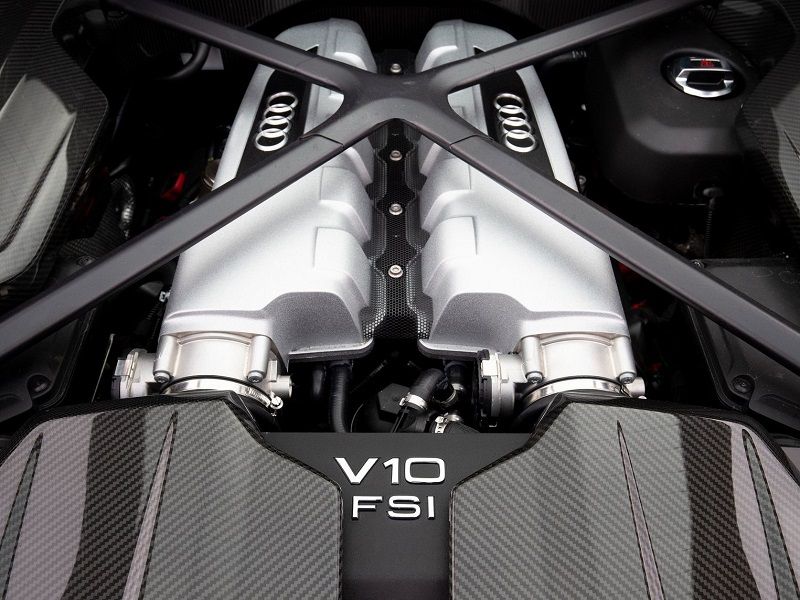
Photo by Audi
Awesome Transmission
Every 2020 Audi R8 gets a dual-clutch seven-speed automatic, but the transmission features more aggressive gear ratios in the Performance model for quicker responses and acceleration. When you’re driving it with an enthusiast's hand, it’s tuned perfectly, keeping the engine above 6,000 rpm where it makes the majority of its power. At 80 mph, the shorter top gear keeps the V10 at 3,250 rpm, which is low enough to keep noise from being an issue.
The transmission does feature a full automatic mode for when you’re feeling lazy, but it’s more fun to select gears yourself with its paddle shifters mounted to its steering wheel. Gear changes are lightning-quick and firm, especially in Performance mode, which is selected with a button on the steering wheel. In Performance mode, the transmission does upshift to second gear for you, just because that gearchange comes so quickly at wide-open throttle, but it’s a true manual after that.
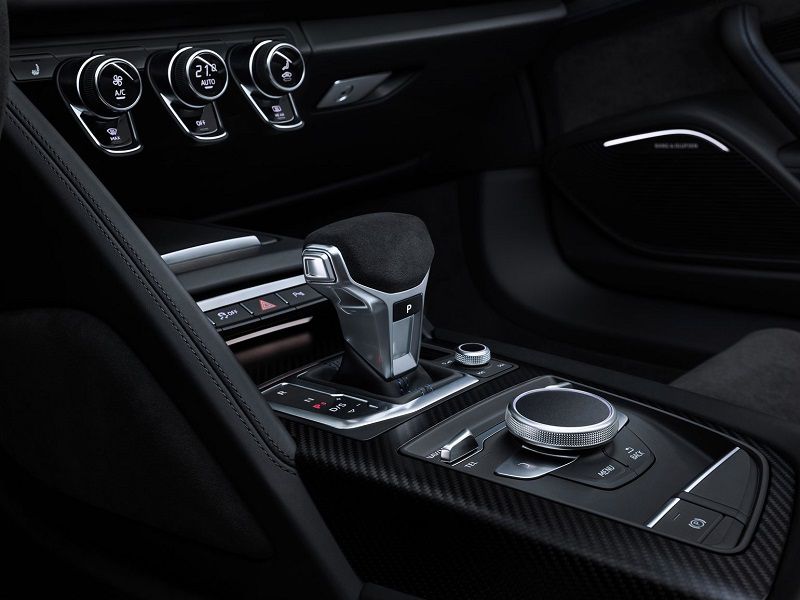
Photo by Audi
Incredible Handling, Improved Steering Feel
Audi has also installed stiffer front suspension bushings and retuned the R8’s steering to increase its weight and feel. Unlike the Lamborghini Huracan, the R8 does not have a rear-wheel steering system, but it is all-wheel drive with a mechanical limited-slip rear differential. The system can send up to 100 percent of the V10’s power to the R8’s front or rear tires to maximize grip and performance, though Dynamic mode tries to keep more power going to the rear axles for a sportier rear-wheel drive feel.
On a fast section of twisty two-lane, the car is incredibly fast and fun to toss around — but more importantly, it doesn’t feel like it’s trying to kill you. Unlike some supercars, the all-wheel drive R8 isn’t just fast, but it’s also forgiving and incredibly easy to drive. Its smart stability control system doesn’t spoil the fun, but it does keep you out of the ditches. Its massive cross-drilled carbon-ceramic brakes are also some of the best in the world; however, they are a bit grabby, which can make smooth stops difficult.
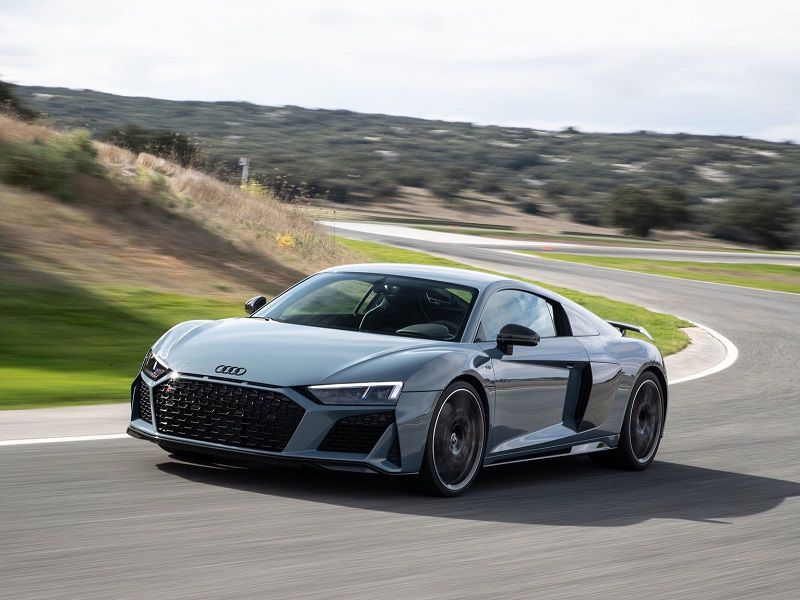
Photo by Audi
Smooth Ride for a Supercar
Base V10 models get an adjustable suspension with magnetic shocks and standard 19-inch wheels and tires. If you’re looking for the smoothest-riding R8, it’s the way to go. Its suspension is tuned a bit softer than the fixed suspension of the Performance model, which rides on standard 20-inch wheels and tires. This year Audi has switched all R8s from Pirelli PZeros to Michelin Pilot Sport 4 S tires for more grip.
Our test car, a Performance Spyder, rode firmly, but it was compliant by supercar standards and comfortable enough for everyday driving. By comparison, the suspension of the Lamborghini Huracan Evo is tuned more aggressively. The new C8 Corvette and McLarens, which have a more technically advanced suspension, still ride more smoothly than the Audi.
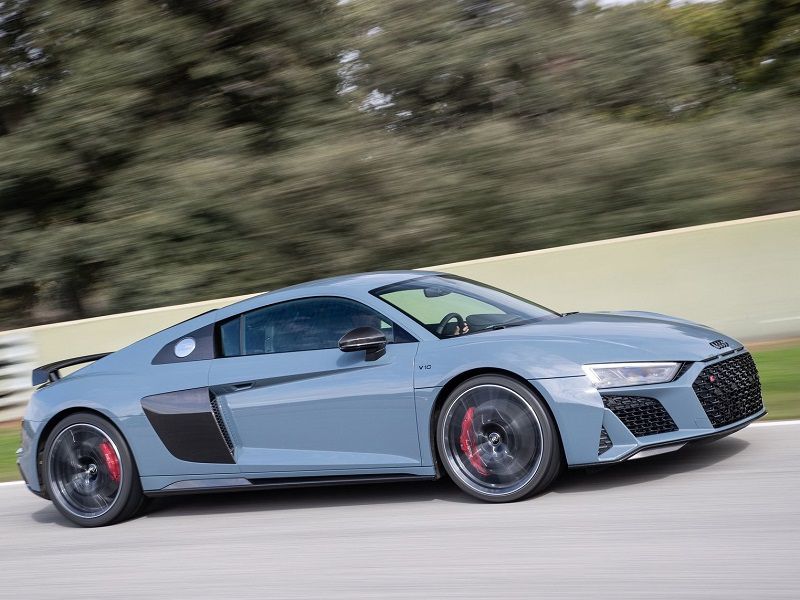
Photo by Audi
Comfortable Interior for a Supercar
Inside, the Audi’s build quality and accommodations are exceptional. Its interior materials live up to the supercar’s lofty price. Although they’re firm and heavily bolstered, its heated seats aren’t too extreme. We found them to be comfortable, even after a few hours behind the wheel, and they're adjustable for height, making it easy to find the right driving position.
Simple and modern, the supercar’s dashboard includes a load of carbon fiber trim, uncomplicated climate and audio controls, and a configurable instrument cluster with clean digital graphics. There’s also a thick leather-wrapped flat-bottom wheel with a big red engine-start button and plenty of storage, including a large bin ahead of the shifter, small door bins, a good-sized glovebox, and two cupholders. Unlike most interiors, there isn’t a screen for the infotainment system on the center of the dashboard; instead, the audio system information and navigation maps are seen ahead of the driver on the instrument panel. We were also surprised the R8 doesn’t have a dual-zone climate control system, which won’t make many passengers happy.
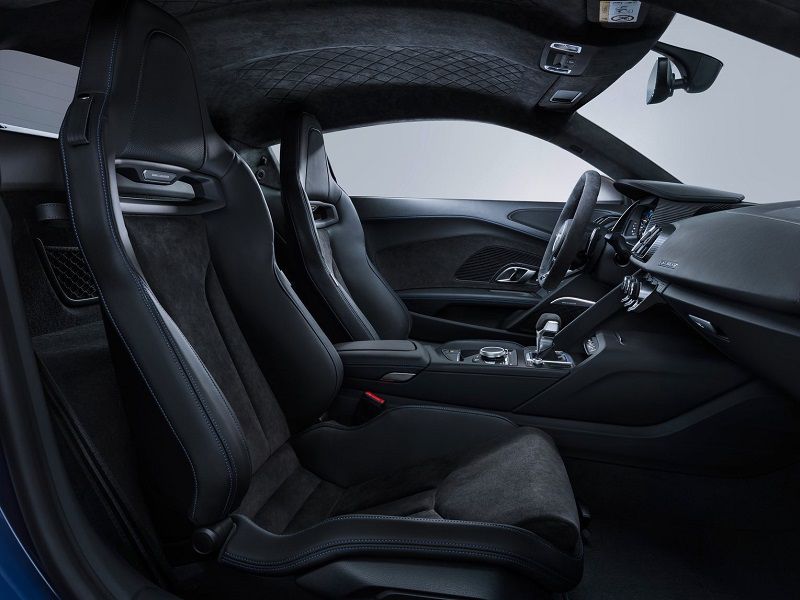
Photo by Audi
Updated Styling Draws a Crowd
This year, Audi has added a new, more angular front end to both R8 models. The new look is more sinister, with a wider honeycomb grille, darkened headlamps, and severe upright elements on each side. The rear bumper has also been reshaped with honeycomb air outlets, a pair of massive oval exhaust pipes, and a beefier rear diffuser. Its redesigned rocker panels now include a gloss black inlay on the base V10 model and a strip of titanium on the Performance. If you’d rather have a strip of carbon fiber, it’s optional.
Like the wheels of the Audi RS5, the R8’s forged rims are now cut on a mill, which allows the designers to think up even more complex angular patterns. Overall, the R8’s new look is more intense than before, and it’s striking from every angle — especially the Spyder with its top folded away. It drops in just 20 seconds. Some say the R8 is styled too conservatively for a supercar, but there’s no denying its beauty and ability to turn heads.
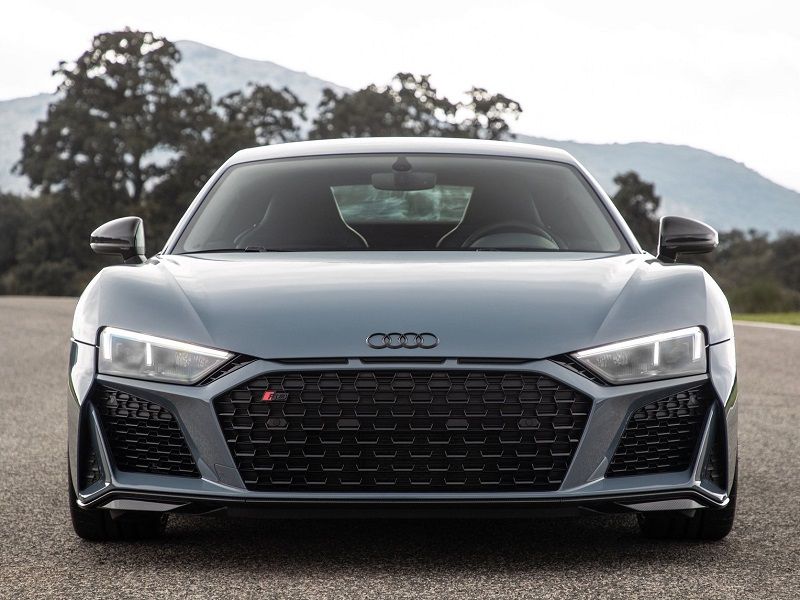
Photo by Audi
Final Thoughts
Even more impressive than the way the 2020 Audi R8 makes speed is its ability to mellow out. Any supercar can go fast, but it takes a higher level of sophistication for such a machine to also achieve quiet and comfort. The new R8 manages to deliver this rare schizophrenia. It’s sick fast when you want it to be, but it’s also refined and even luxurious when you need it to be. It’s a neat trick few cars can pull off.
If you’re in the market for an exotic high-performance coupe or convertible, the 2020 Audi R8 is an exceptional choice. It isn’t the fastest supercar you can buy, but it’s one of the best.
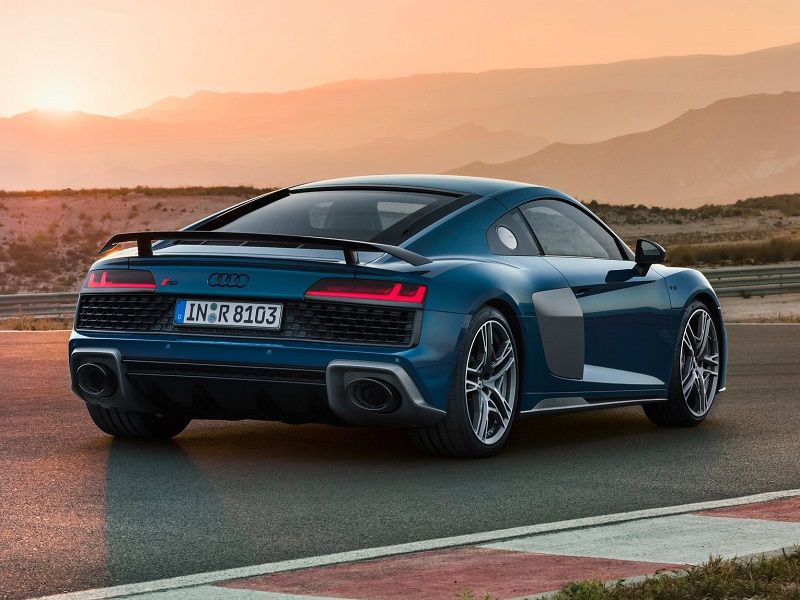
Photo by Audi